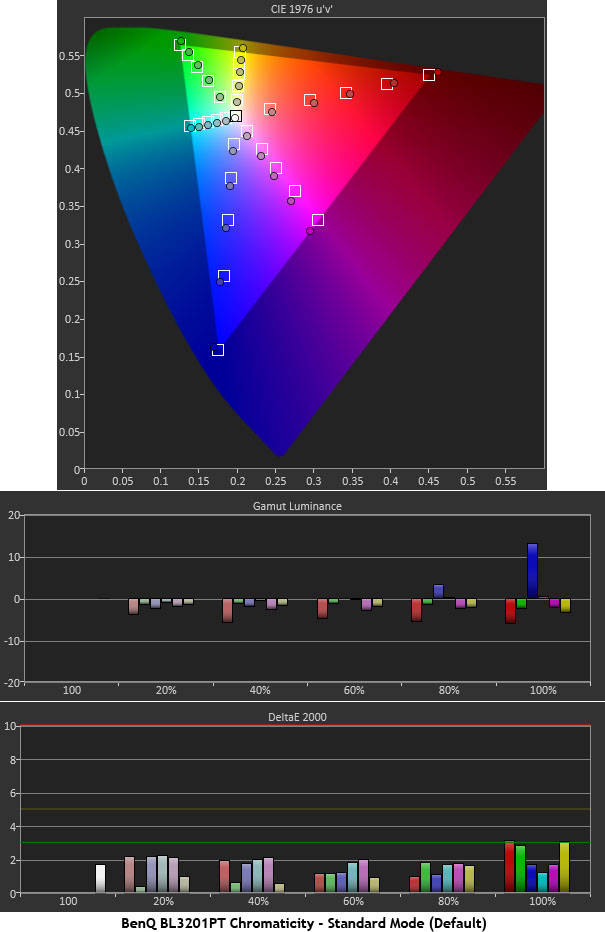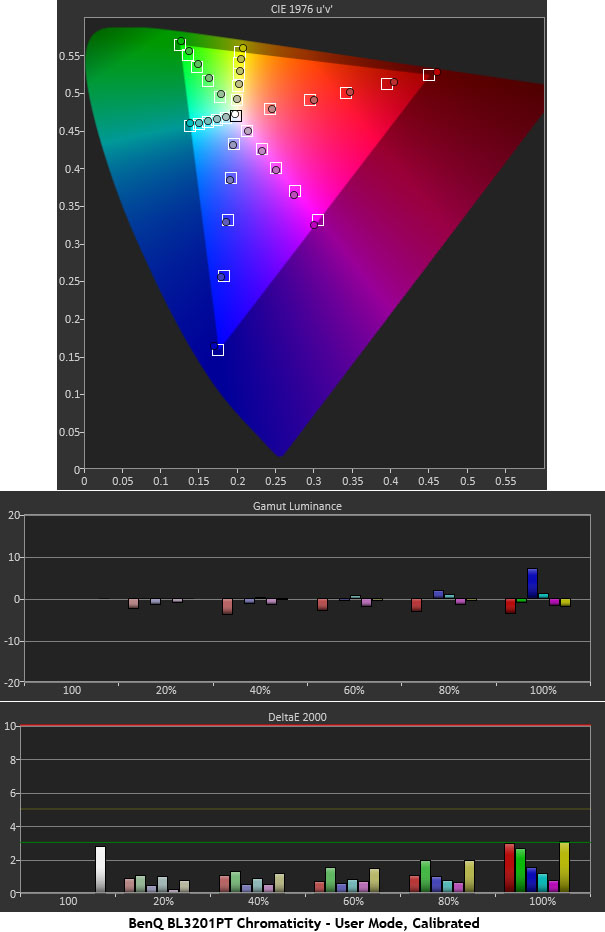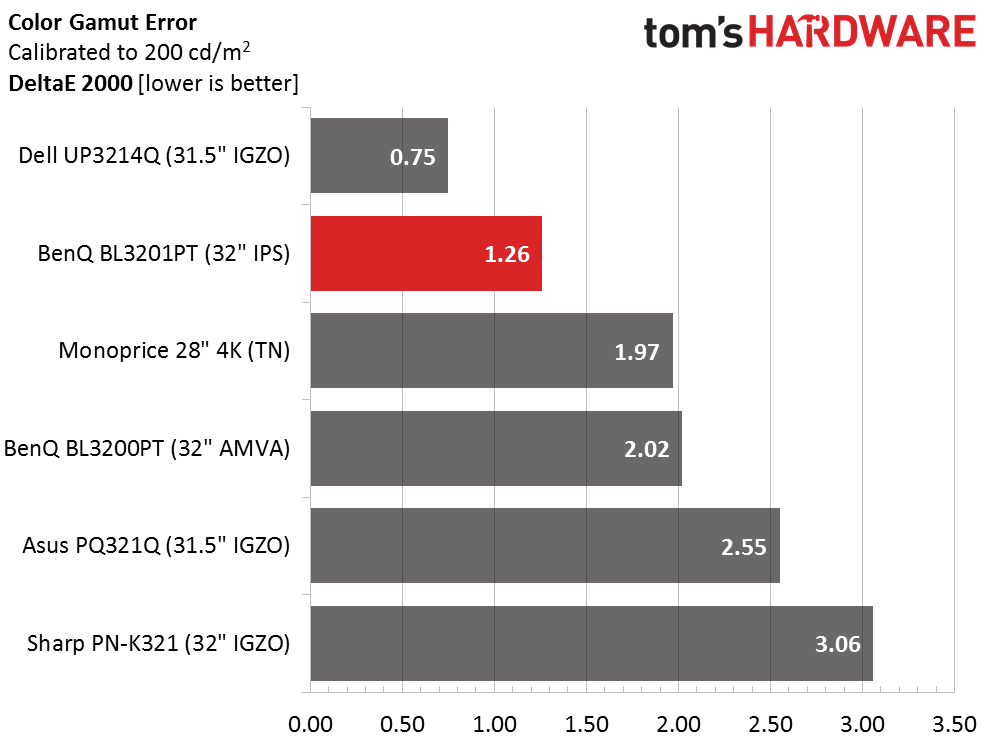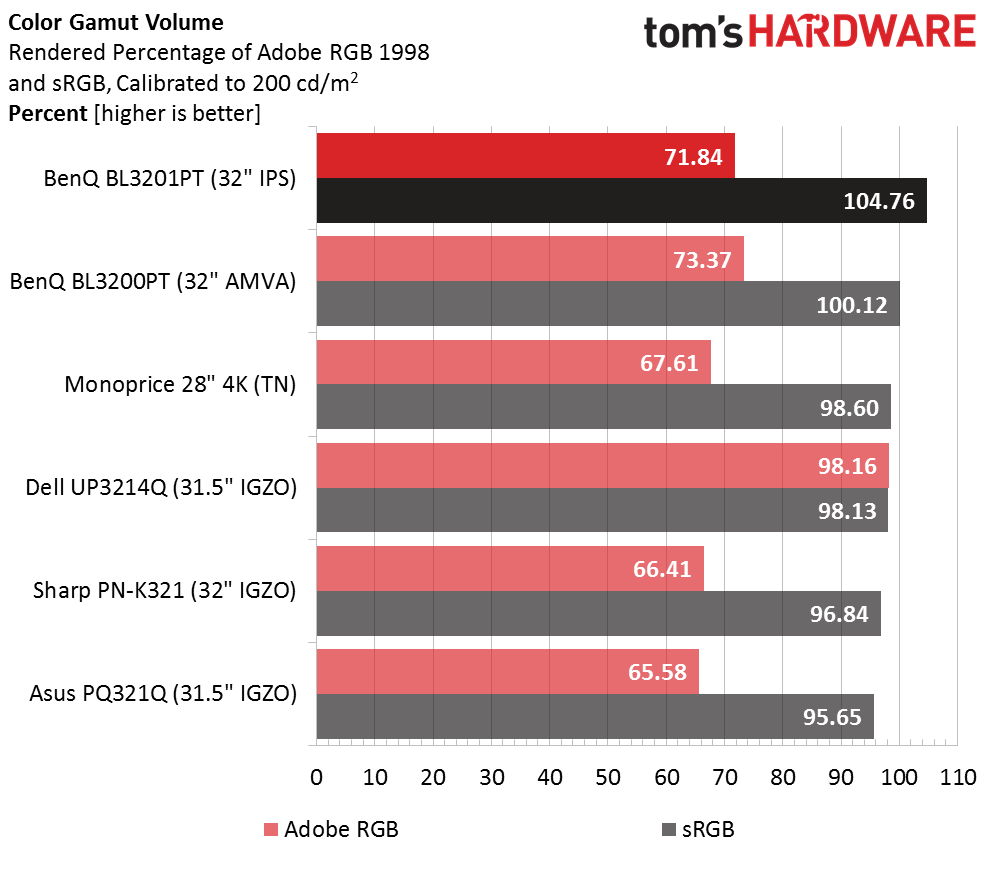BenQ BL3201PT 32-inch Ultra HD Monitor Review
The first-generation 32-inch Ultra HD monitors came out at over $3000. They’ve dropped in price of course, but BenQ’s new BL3201PT is debuting at a more aggressive MSRP of $1100. We've even seen it selling for under $1000. Today we test its performance.
Why you can trust Tom's Hardware
Results: Color Gamut And Performance
For details on our color gamut testing and volume calculations, please click here.
Like our grayscale and gamma results, the BL3201PT’s chroma performance is quite good in its default Standard picture mode. Only a small spike in blue luminance stands out on an otherwise excellent chart. On the CIE graph, you can see a little over-saturation in red and a hue error in magenta. The latter should be cleared up by the grayscale calibration.
Magenta’s hue improves, though not all the way to the target. Color luminances are pretty much perfect except for blue, but it’s only a little high. The DeltaE errors go from small to miniscule.
Now we return to the comparison group:
Remember that Dell positions the UP3214Q as a professional screen, and it earns that title. BenQ hits a home run with its second-place finish in this group of mostly pricey screens. Our calibration takes the average error from 1.72 to 1.26dE, which is like going from really good to really really good. Truly, we measure a professional-grade result.
Gamut Volume: Adobe RGB 1998 And sRGB
Due to an over-saturated red primary, the BL3201PT’s sRGB gamut volume exceeds 100 percent. To take advantage of this, you’ll need to match the rest of your production chain (printer and camera). While most photographers prefer wide-gamut screens, a little bonus sRGB color can be useful too. And we’ll remind you again of the cost savings offered by this BenQ.
Get Tom's Hardware's best news and in-depth reviews, straight to your inbox.
Current page: Results: Color Gamut And Performance
Prev Page Results: Grayscale Tracking And Gamma Response Next Page Results: Viewing Angles, Uniformity, Response And Lag
Christian Eberle is a Contributing Editor for Tom's Hardware US. He's a veteran reviewer of A/V equipment, specializing in monitors. Christian began his obsession with tech when he built his first PC in 1991, a 286 running DOS 3.0 at a blazing 12MHz. In 2006, he undertook training from the Imaging Science Foundation in video calibration and testing and thus started a passion for precise imaging that persists to this day. He is also a professional musician with a degree from the New England Conservatory as a classical bassoonist which he used to good effect as a performer with the West Point Army Band from 1987 to 2013. He enjoys watching movies and listening to high-end audio in his custom-built home theater and can be seen riding trails near his home on a race-ready ICE VTX recumbent trike. Christian enjoys the endless summer in Florida where he lives with his wife and Chihuahua and plays with orchestras around the state.
-
blackmagnum I wouldn't want to bump it over and drop it from the table, because the stand looks so tipsy.Reply -
avatar_raq I wonder why all the links to Amazon belong to the BL3201PH not the reviewed "PT" model. Am I missing something?Reply -
I Hate Nvidia I Don't Know Why monitor vendors can't make a decent 28 inch IPS UHD monitor below 500 $ whereas I bought my LG UB820T 42 inch IPS 120 Hz UHD TV for only 630$ ,and it comes with the amazing magic remote and TV tuner and smart TV support, WIFI and LAN , USB 3 and 3 HDMI 2.0 ports!Reply -
qwfgbn Dell P2415Q and P2715Q are 4K 60HZ IPS panels which can be found for around 600$ on amazon.Reply -
ohim Why is everybody stating about Luminance / Brightness as "higher is better ". I had an Iiyama 27" IPS pannel that had over 350 cd you can`t even use that monitor at 100% brightness, you can actually feel the heat from the monitor on your face. Best use was at around 25 to 50% brightness ...had to return it though due to flickering .. my eyes were going insane with that monitor.Reply -
nukemaster I hate to ask, but how is the glow?Reply
I wouldn't want to bump it over and drop it from the table, because the stand looks so tipsy.
The stand is sturdy since the 3200PT(2560 x 1440 MVA) was very solid with the same stand.
Why is everybody stating about Luminance / Brightness as "higher is better ". I had an Iiyama 27" IPS pannel that had over 350 cd you can`t even use that monitor at 100% brightness, you can actually feel the heat from the monitor on your face. Best use was at around 25 to 50% brightness ...had to return it though due to flickering .. my eyes were going insane with that monitor.
I think the brighter is better has carried over from cell phone reviews or something. Working in a very bright area could also benefit from extra brightness. On the plus side almost all BenQ screens use voltage based dimming and not PWM. This should allow you to get a dimmer screen without the flickering(not that it bothers me).
I personally have my screens at a much lower setting as well. -
Eggz Siiiick! This is the first 4K screen I've seen that seems reasonable in terms of price, performance, size, and image quality.Reply -
burmese_dude "it’s selling on the street for under $1000." I wonder if they sell these on my street. I need to call and ask.Reply -
ubercake I thought we'd start seeing some sort of adaptive sync technology on just about every monitor by now. I can't get excited about anything that doesn't have it.Reply



